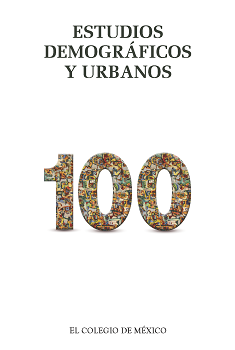Ciudades y consumo de bienes agrícolas. Transformaciones del consumo alimentario en el contexto de cambios en el comercio agrícola y las cadenas comerciales
Publicado 2018-12-10
Cómo citar
-
Resumen2372
-
PDF (español)766
-
En línea (español)521
Descargas
Derechos de autor 2018 Estudios Demográficos y Urbanos

Esta obra está bajo una licencia internacional Creative Commons Atribución-NoComercial-SinDerivadas 4.0.
Métrica
Resumen
Si vivimos en una ciudad, tenemos a diario en nuestro plato alimentos que provienen del mundo entero. Se han dado transformaciones recientes en el consumo alimentario urbano, en su contexto sociocultural y político, así como en sus consecuencias en la salud pública, el ambiente y las relaciones de campo (espacio proveedor de recursos naturales para la urbe)- ciudad (espacio de consumo). En 2014 más de 54% de la población mundial vivía en zonas urbanas (UNDESA, 2014). Las ciudades han crecido en población, superficie y número, habiéndose localizado la mayor parte de este crecimiento en el Sur Global. Los procesos de expansión urbana y de urbanización y rurbanización de comunidades rurales han transformado las nociones de campo y ciudad y han producido formas híbridas, que implican interacciones entre estos espacios y afectan el uso del suelo, la producción de alimentos y energía, el acceso a la alimentación y sus patrones de consumo.
Referencias
- Appendini, K. (2001). De la milpa a los tortibonos. La reestructuración de la política alimentaria en México. Ciudad de México: El Colegio de México, A. C. / UNRISD.
- Baabou, W., Grunewald, N., Ouellet-Plamondon, C., Gressot, M. y Galli, A. (2017). The ecological footprint of mediterranean cities: Awareness creation and policy implications. Environmental Science & Policy, 69, 94-104. DOI: https://doi.org/10.1016/j.envsci.2016.12.013
- Borras Jr., S. M., Franco, J. C., Isakson, R., Levidow, L. y Vervest, P. (2014). Towards understanding the politics of flex crops and commodities: Implications for research and policy advocacy. Think Piece Series on Flex Crops & Commodities, 1. Amsterdam: Transnational Institute (TNI). Recuperado de: https://www.tni.org/files/download/flexcrops01.pdf DOI: https://doi.org/10.1080/03066150.2015.1036417
- Clapp, J. (2015a). Food security and international trade. Unpacking disputed narratives. The State of Agricultural Commodity Markets 2015-16. (Documento de trabajo). Food and Agriculture Organization.
- Clapp, J. (2015b). Distant agricultural landscapes. Sustainability Science, 10(2), 305-316. DOI: https://doi.org/10.1007/s11625-014-0278-0
- FAO (2017). Food Waste [Infografía]. Food and Agriculture Organization. Recuperado de http://www.fao.org/assets/infographics/pdfimg/FAO-Infographic-FoodWaste-en.jpg
- Global Footprint Network (2015). The state of the states report. A new perspective on the wealth of our nation. Global Footprint Network. Recuperado de https://www.footprintnetwork.org/2015/07/14/states/
- Godar, J., Persson, U. M., Tizado, E. J. y Meyfroidt, P. (2015). Methodological and ideological options. Towards more accurate and policy relevant footprint analyses: Tracing fine-scale socio-environmental impacts of production to consumption. Ecological Economics, 112, 25-35. DOI: https://doi.org/10.1016/j.ecolecon.2015.02.003
- Gresser, C. y Tickell, S. (2002). Mugged: Poverty in your coffee cup. Oxfam International. Recuperado de https://www.oxfamamerica.org/publications/mugged-poverty-in-your-coffee-cup/ DOI: https://doi.org/10.3362/9780855988029
- Holt-Giménez, E. y Shattuck, A. (2011). Food crises, food regimes and food movements: Rumblings of reform or tides of transformation?. Journal of Peasant Studies, 38(1), 109-144. DOI: https://doi.org/10.1080/03066150.2010.538578
- IFPRI (2011). Maize [Infografía]. Recuperado de http://insights.ifpri.info/files/2011/10/maize_infogrph_v01-011.png
- McMichael, P. (2005). Global development and the corporate food regime. Research in Rural Sociology and Development, 11(5), 265-299. DOI: https://doi.org/10.1016/S1057-1922(05)11010-5
- Panhuysen, S. y Pierrot, J. (2014). Coffee Barometer 2014. La Haya, Países Bajos: Hivos / International Union for the Conservation of Nature Netherlands / Oxfam Novib / Solidaridad / World Wide Fund for Nature.
- Popkin, B. M., Adair, L. S. y Wen Ng, S. (2012). Now and then. The global nutrition transition: The pandemic of obesity in developing countries. Nutrition Reviews, 70(1), 3-21. DOI: https://doi.org/10.1111/j.1753-4887.2011.00456.x
- Stoll-Kleemann, S. y O’Riordan, T. (2015). The sustainability challenges of our meat and dairy diets. Environment, 57(3), 34-48. DOI: https://doi.org/10.1080/00139157.2015.1025644
- UN DESA. (2014). World urbanization prospects: The 2014 revision, highlights (ST/ESA/SER.A/352). United Nations Department of Economic and Social Affairs, Population Division.
- World Economic Forum (2017). Which countries spend the most on food? [Infografía]. Recuperado de https://www.weforum.org/agenda/2016/12/this-map-shows-how-much-each-country-spends-on-food/
- Weis, T. (2013). The meat of the global food crisis. Journal of Peasant Studies, 40(1), 65-85. DOI: https://doi.org/10.1080/03066150.2012.752357
- WHO (2016). Global report on diabetes. World Health Organization. Recuperado de apps.who.int/iris/bitstream/10665/204871/1/9789241565257_eng.pdf
- WWF (2016). Living Planet Report 2016. Risk and resilience in a new era. Gland, Suiza: World Wide Fund for Nature International. Recuperado de http://awsassets.panda.org/downloads/lpr_living_planet_report_2016.pdf


